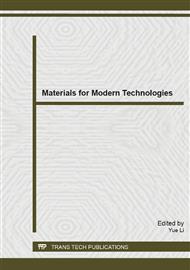[1]
K. Narita, M. Niinomi, M. Nakai, J. Hieda, K. Oribe, Specific characteristics of mechanically and biologically compatible titanium alloy rods for use in spinal fixation applications, Mater. Lett. 86 (2012) 178–181.
DOI: 10.1016/j.matlet.2012.07.027
Google Scholar
[2]
S.B. Gabriel, J.V.P. Panaino, I.D. Santos, L.S. Araujo, P.R. Mei, L.H. de Almeida, C.A. Nunes, Characterization of a new beta titanium alloy, Ti-12Mo-3Nb, for biomedical applications, J. Alloys Compd. 536 (2012) S208–S210.
DOI: 10.1016/j.jallcom.2011.11.035
Google Scholar
[3]
W.S. Lee, C.W. Chen, High temperature impact properties and dislocation substructure of Ti-6Al-7Nb biomedical alloy, Mater. Sci. Eng. A 576 (2013) 91–100.
DOI: 10.1016/j.msea.2013.03.088
Google Scholar
[4]
A. Choubey, R. Balasubramaniam, B. Basu, Effect of replacement of V by Nb and Fe on the electrochemical and corrosion behavior of Ti-6Al-4V in simulated physiological environment, J. Alloys Compd. 381 (2004) 288–294.
DOI: 10.1016/j.jallcom.2004.03.096
Google Scholar
[5]
W.F. Cui, Z. Jin, A.H. Guo, L. Zhou. High temperature deformation behavior of α+β-type biomedical titanium alloy Ti-6Al-7Nb, Mater. Sci. Eng. A 499 (2009) 252–256.
DOI: 10.1016/j.msea.2007.11.109
Google Scholar
[6]
A.H. Guo, W.F. Cui, X.H. Liu, L. Zhou, Oxidation behavior and wear resistance of biomedical Ti6Al7Nb alloy, Journal of Northeastern University (Natural Science) 29 (2008) 996–999.
Google Scholar
[7]
F. Pilehva, A. Zarei-Hanzaki, M. Ghambari, H.R. Abedi, Flow behavior modeling of a Ti-6Al-7Nb biomedical alloy during manufacturing at elevated temperatures, Mater. Des. 51 (2013) 457–465.
DOI: 10.1016/j.matdes.2013.04.046
Google Scholar
[8]
P. Vo, M. Jahazi, S. Yue, P. Bocher, Flow stress prediction during hot working of near-α titanium alloys, Mater. Sci. Eng. A 447 (2007) 99–110.
DOI: 10.1016/j.msea.2006.10.032
Google Scholar
[9]
S. Guo, D. Li, X. Wu, X. Xu, P. Du, J. Hu, Characterization of hot deformation behavior of a Zn-10. 2Al-2. 1Cu alloy using processing maps. Mater. Des. 41(2012) 158–166.
DOI: 10.1016/j.matdes.2012.04.044
Google Scholar
[10]
K.P. Rao, Y.V.R.K. Prasad , K. Suresh, Materials modeling and simulation of isothermal forging of rolled AZ31B magnesium alloy: anisotropy of flow. Mater. Des. 32 (2011) 2545–2553.
DOI: 10.1016/j.matdes.2011.01.050
Google Scholar
[11]
P. Changizian, A. Z. Hanzaki, A. A. Roostaei, The high temperature flow behavior modeling of AZ81 magnesium alloy considering strain effects. Mater. Des. 39 (2012) 384–389.
DOI: 10.1016/j.matdes.2012.02.049
Google Scholar
[12]
Y. Ning, Z. Yao, H. Li, H. Guo, Y. Tao, Y. Zhang, High temperature deformation behavior of hot isostatically pressed P/M FGH4096 superalloy. Mater. Sci. Eng. A 527 (2010) 961–966.
DOI: 10.1016/j.msea.2009.09.011
Google Scholar


